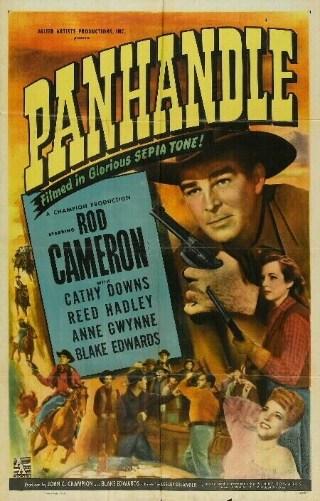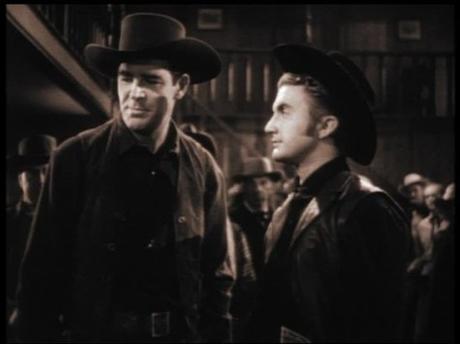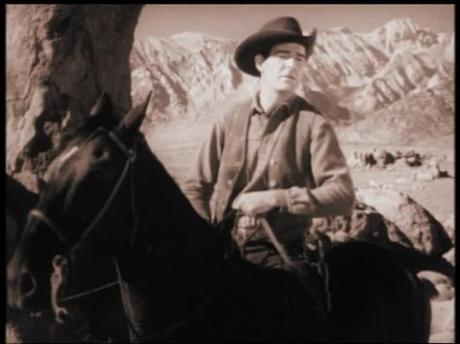
Certain plot devices come up time and again in westerns, so much so that they can start to feel like old friends after a while. On occasion we even get a whole cluster of them all intermingled in one movie, although one tends to dominate when such a situation arises. Panhandle (1948) blends together the tale of the town tamer, the outlaw forced back into his old ways, and the perennial matter of settling scores. It’s that latter element – the quest for revenge, or perhaps it would be more accurate to talk of justice here – that comes to the fore in another stylish example of Lesley Selander’s work.
Mexico has frequently been portrayed on screen as a land of opportunity from a westerner’s perspective. Sometimes it has held out the possibility of attaining riches, at others of regaining something of the mythical freedom eaten up by the relentless advance of civilization. And it has also been viewed as the home of the second chance, a place of refuge and redemption of sorts, for the badman in search of spiritual solace. John Sands (Rod Cameron) is one of those men, a gunfighter trying to put his violent past behind him by living a simple but honest existence south of the border. Initially, it looks as though he has achieved some kind of peace selling leather goods, but unexpected news from the north is about to change all that. A young woman (Cathy Downs), unaware of his former identity and notoriety, drops the bombshell that his brother has been murdered in the town of Sentinel in the Texas Panhandle. In that instant, Sands’ life is transformed as he has been forced back to the way of the gun. His mission to exact retribution for the killing means a return to the US, to his own dark past and all the attendant dangers crossing the border represents to him – aside from confronting the guilty men, there’s also the little matter of an outstanding warrant for his arrest still circulating in the Lone Star state. Sands is going to have to negotiate this, and also the attentions of two very different women, before he can reach some form of closure and continue living on the terms he has chosen for himself.

The first thing one notices about the movie is the use of sepia tone, a look that I’ve never been especially fond of. In my mind, this kind of tinted photography will be forever associated with material of a much older vintage – silent films mainly – although that’s perhaps the thinking behind its use here, to reinforce the fact that the tale is unfolding in a different era. Whatever the reasoning, it’s a process that I find I get used to quick enough and it soon ceases to be something worth remarking on. If I have any particular issues, they relate to a few areas of the script that I feel were almost discarded after their introduction suggested something more was to be made of them. The question of Sands’ legal status in the US pops up early on when a lawman, played by Rory Mallinson, tries unsuccessfully to detain him. It’s mentioned again when certain interests in Sentinel make a play for his services as a town tamer, but then is essentially ignored. Even that aspect, the potential hiring of the outsider to clean up the undesirable elements gets elbowed aside when it looks like there might have been scope for some kind of commentary on way those with a less savory past were accepted on sufferance in times of need.
More time is allotted to the suggestion of a romance with Cathy Downs’ character, although this never develops, and a more overt one with Anne Gwynne. The latter situation doesn’t work all that convincingly in my opinion, and I can’t help but feel it’s a shame the storyline featuring Downs wasn’t built up more as there was more potential which could have been tapped into in that situation. Nevertheless, even if these aspects are not entirely satisfactory, they don’t weaken the film. Selander’s sure direction keeps the whole affair moving forward and switches the action smoothly between the studio backlot and the Lone Pine locations. As one might expect from this director, the action is neatly handled too, especially a fine bar room brawl and the climactic shootout on the muddy streets of Sentinel, with the rain pounding down and the harshly lit muzzle flashes signalling death for some and victory for others.

Panhandle was one of a number of films Rod Cameron made for Selander and it offered him a good rugged role. He was one of those actors who looked comfortable in westerns and provided a solid screen presence. This part was a good fit since he was believable as a hero and also as a villain in other films, so playing the outlaw struggling to reform himself was certainly within his range. One of the most enjoyable scenes in the picture comes when he’s pressed by a young Blake Edwards (who also had a co-writing credit for the movie) to divulge the details of the time he faced down Billy the Kid. Cameron draws the tale out wonderfully, holding the younger man rapt and milking the story for all its worth. And then he delivers a punchline that practically floors Edwards, and the viewer too, with its sheer audacity – a lovely moment. Cathy Downs and Anne Gwynne were an extremely attractive pair of leading ladies although, as I said above, it’s a pity the former isn’t used a little better. As for villains, Edwards is fine as the flashy hothead and Reed Hadley does good work too as his suave and deadly boss. In support, it’s nice to see familiar faces like Rory Mallinson and John Ford favorite J Farrell MacDonald, albeit in small roles.
Panhandle is available on DVD in both the US and the UK in Darn Good Westerns collections, from VCI and Odeon (now Screenbound) respectively. I have the UK edition and the transfer is just fair. The image generally looks soft and quite muddy in places – I think the images i used above (despite the fact they’re reduced in size) give an indication of the picture quality. The disc offers the theatrical trailer as the sole bonus feature. This is a pretty good Selander film told in his usual economical style. The script, a debut effort for both Blake Edwards and John C Champion, has plenty of ideas and even if all of them aren’t as fully developed as they might have been, what happens on screen is consistently interesting. Another solid low-budget production with quite a bit to be said in its favor.
